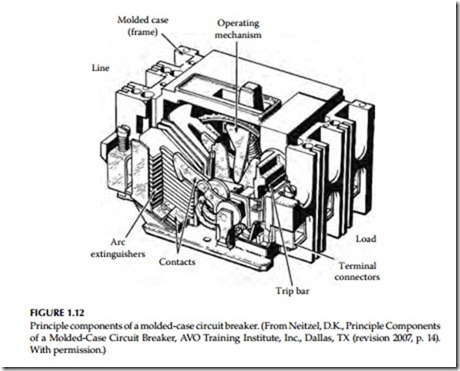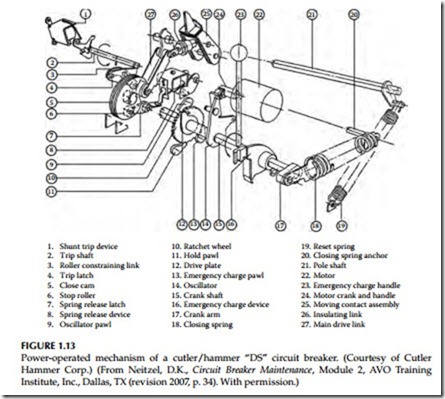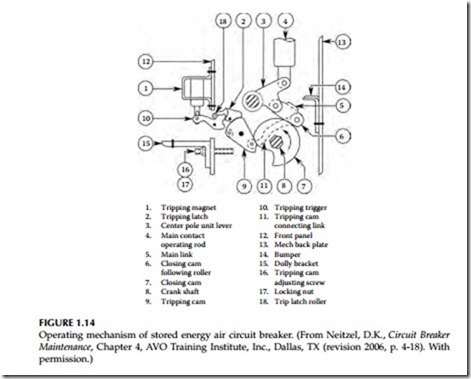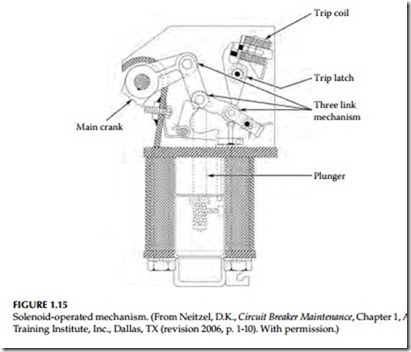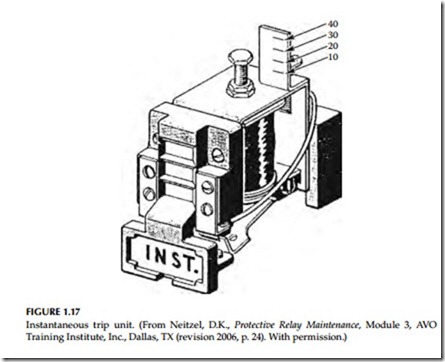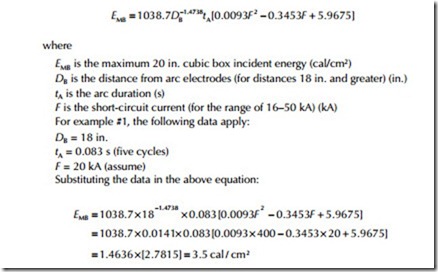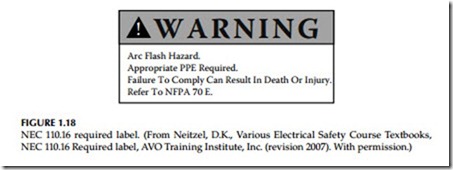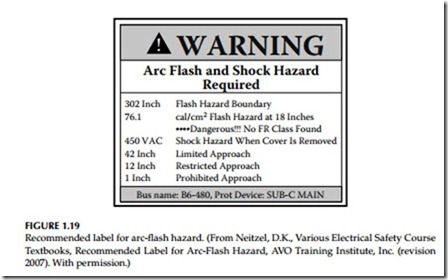Maintenance of Protective Devices and their Impact on Arc-Flash Hazard Analysis
EPM and testing is not only important for the reliability and integrity of electrical distribution systems, but also for the safety and protection of people. PM of overcurrent protective devices and breakers, is often overlooked, performed infrequently, or is performed improperly. This maintenance and testing of the protective devices has taken on a greater importance because the operating times of these devices are credited in the arc-flash hazard anal- ysis, the selection of personal protective equipment (PPE) and protecting the worker from shock and arc-flash hazards. To show why the maintenance and reliability of protective devices has become extremely important for protect- ing workers from arc-flash hazard and for labeling of electrical equipment to warn workers of such hazard, we will review and discuss the following:
1. Industry practice and regulatory bases for maintenance and testing of
• Molded-case circuit breakers
• Low-voltage power circuit breakers
• Medium-voltage circuit breakers
• Protective relays
2. Failure statistics for overcurrent protective devices
3. Impact of overcurrent protective devices on arc-flash hazards
Bases of Maintenance and Testing of Protective Devices
The NEC Articles 210-20, 215-3, 240-1, and 240-3 specify requirements for the protection of electrical equipment and conductors. The Fine Print Note (FPN) to Article 240-1, Scope, states, “Overcurrent protection for conductors and equipment is provided to open the circuit if the current reaches a value that will cause an excessive or dangerous temperature in conductors or conductor insu- lation.” To protect against overcurrent conditions, the only way to ensure that circuit breakers, overcurrent relays, and protective devices are working cor- rectly is through regular maintenance and testing of these devices. There are several steps that must be taken in order to establish an effective maintenance program for the breakers and overcurrent protective devices. The first step in correctly maintaining electrical equipment and overcurrent protective devices is to understand the requirements and recommendations for electrical equip- ment maintenance from various sources. Examples of such sources include, but are not limited to, the manufacturer’s instructions, NFPA 70B, IEEE Standard 902 (Yellow Book), NEMA AB-4, NETA Specs, NFPA 70E and this book.
The second step in performing maintenance and testing is to provide adequate training and qualification for employees. NFPA 70E, Section 205.1 states, “Employees who perform maintenance on electrical equipment and installations shall be qualified persons … and shall be trained in and be familiar with the specific maintenance procedures and tests required.” The NEC defines a qualified person as “One who has skills and knowledge related to the construction and operation of the electrical equipment and installations and has received safety training on the hazards involved.” It is vitally impor- tant that employees be properly trained and qualified to maintain electrical equipment in order to increase the equipment and system reliability, as well as the employee’s safety.
The third step is to have a written, effective EPM program. NFPA 70B makes several very clear statements about an effective EPM program. These statements include
1. Deterioration of electrical equipment is a normal process, but that does not mean that equipment failure is eminent. If unchecked, dete- rioration will eventually cause equipment malfunction or complete failure. There are several factors that can accelerate the deterioration process, such as the environment, overload conditions, or severe duty cycles. An effective EPM program will help to identify and correct any or all of these conditions.
2. In addition to the deterioration problem, there are several other potential causes of equipment failure. These causes include, but are not limited to, load changes, circuit alterations, improper or misad- justed settings of protective devices, improperly selected protective devices, and changing voltage conditions.
3. With the absence of an effective EPM program, management assumes a greater responsibility for and an increased risk of a serious electrical failure, as well as the consequences.
4. An effective EPM program, that is administered properly, will reduce costly shutdowns and outages, reduce accidents, and save lives. These programs will identify impending troubles and apply solutions to correct them, before they become major problems that require time consuming and more expensive solutions.
IEEE Standard 902 states: “In planning an EPM program, consideration must be given to the costs of safety, the costs associated with direct losses due to equipment damage, and the indirect costs associated with downtime or lost or inefficient production.”
The forth step is that all maintenance and testing of electrical protective devices must be accomplished in accordance with the manufacturer’s instruc- tions. NFPA 70E adds to this by stating: “Protective devices shall be maintained to adequately withstand or interrupt available fault current.” It goes on to state, “Circuit breakers that interrupt faults approaching their ratings shall be inspected and tested in accordance with the manufacturers’ instructions.” In the absence of the manufacturer’s instructions, the NETA Maintenance Testing Specifications for Electrical Power Distribution Equipment and Systems is an excellent source of information for performing the required maintenance and testing of these devices. However, the manufacturer’s
time–current curves would also be required in order to properly test each protective device.
The fifth and final step that will be addressed here is the arc-flash hazard considerations. One of the key components of the flash hazard analysis, which is required by NFPA 70E and OSHA, is the clearing time of the protective devices, primarily circuit breakers, fuses, and protective relays. Fuses, although they are protective devices, they do not have operating mecha- nisms that would require periodic maintenance. However, fuses should be inspected to verify that they are in good working condition.
We will address some of the issues concerning maintenance and testing of the protective devices, according to the manufacturer’s instructions. We will also address how protective device maintenance relates to the electrical arc-flash hazard.
Molded-case circuit breakers:∗ Generally, maintenance on molded-case circuit breakers is limited to mechanical mounting, electrical connections, and periodic manual operation. Most lighting, appliance, and power panel circuit breakers have riveted frames and are not designed to be opened for internal inspection or maintenance. All other molded-case circuit breakers that are Underwriters Laboratory (UL) approved are factory-sealed to prevent access to the calibrated elements. An unbroken seal indicates that the mechanism has not been tam- pered with and that it should function as specified by UL or its manufacture. A broken seal voids the UL and the manufacturers’ warranty of the device. In this case, the integrity of the device would be questionable. The only excep- tion to this would be a seal being broken by a manufacturer’s authorized facil- ity. Molded-case circuit breakers receive extensive testing and calibration at the manufacturers’ plants. These tests are performed in accordance with UL 489, Standard for Safety, Molded-Case Circuit Breakers, Molded-Case Switches and Circuit Breaker Enclosures. Molded-case circuit breakers, other than the riveted frame types, are permitted to be reconditioned and returned to the manufacturer’s original condition. In order to conform to the manufacturer’s original design, circuit breakers must be reconditioned according to recognized standards. The Professional Electrical Apparatus Recyclers League (PEARL) companies follow rigid standards to recondition low-voltage industrial and commercial molded- case circuit breakers. It is highly recommended that only authorized profes- sionals recondition molded-case circuit breakers. Circuit breakers installed in a system are often forgotten. Even though the breakers have been sitting in place supplying power to a circuit for years, there are several things that can go wrong. The circuit breaker can fail to open due to a burned out trip coil or because the mechanism is frozen due to dirt, dried lubricant, or corrosion. The overcurrent device can fail due to inactivity or a burned out electronic compo- nent. Many problems can occur when proper maintenance is not performed and the breaker fails to open under fault conditions. This combination of events can result in fires, damage to equipment, or injuries to personnel.
![]() ∗ Text from here to Section 1.9.2 is used with permission from D.K. Neitzel. Article is titled Protective Devices Maintenance as it applies to the arc/flash hazard.
∗ Text from here to Section 1.9.2 is used with permission from D.K. Neitzel. Article is titled Protective Devices Maintenance as it applies to the arc/flash hazard.
All too often, a circuit breaker fails because the minimum maintenance (as specified by the manufacturer) was not performed or was performed improp- erly. Small things, like failing to properly clean and/or lubricate a circuit breaker, can lead to operational failure or complete destruction due to overheating of the internal components. Common sense, as well as manufac- turers’ literature, must be used when maintaining circuit breakers. Most manufacturers, as well as NFPA 70B, recommend that if a molded-case circuit breaker has not been operated, opened, or closed, either manually or by automatic means, within as little as 6 months time, it should be removed from service and manually exercised several times. This manual exercise helps to keep the contacts clean due to their wiping action and ensures that the operating mechanism moves freely. This exercise, however, does not operate the mechanical linkages in the tripping mechanism (Figure 1.12). The only way to properly exercise the entire breaker operating and tripping mechanisms is to remove the breaker from service and test the overcur- rent and short-circuit tripping capabilities. A stiff or sticky mechanism can cause an unintentional time delay in its operation under fault conditions. This could dramatically increase the arc-flash incident energy level to a value in excess of the rating of PPE. There will be more on incident energy later.
Another consideration is addressed by OSHA in 29 CFR 1910.334(b)(2) which states:
Reclosing circuits after protective device operation. After a circuit is de-energized by a circuit protective device, the circuit may NOT be manually reenergized until it has been determined that the equipment and circuit can be safely reenergized. The repetitive manual reclosing of circuit breakers or reenergizing circuits through replaced fuses is prohibited.
Note. When it can be determined from the design of the circuit and the overcurrent devices involved and that the automatic operation of a device was caused by an overload rather than a fault condition, no examination of the circuit or connected equipment is needed before the circuit is reenergized.
The safety of the employee, manually operating the circuit breaker, is at risk if the short-circuit condition still exists when reclosing the breaker. OSHA no longer allows the past practice of resetting circuit breaker one, two, or three times before investigating the cause of the trip. This previous practice has caused numerous burn injuries that resulted from the explosion of electrical equipment. Before resetting a circuit breaker, it, along with the circuit and equipment, must be tested and inspected, by a quali- fied person, to ensure a short-circuit condition does not exist and that it is safe to reset.
Any time a circuit breaker has operated and the reason is unknown, the breaker must be inspected. Melted arc chutes will not interrupt fault currents. If the breaker cannot interrupt a second fault, it will fail and may destroy its enclosure and create a hazard for anyone working near the equipment.
To further emphasize this point the following quote from the NEMA is provided:
After a high level fault has occurred in equipment that is properly rated and installed, it is not always clear to investigating electricians what damage has occurred inside encased equipment. The circuit breaker may well appear virtually clean while its internal condition is unknown. For such situations, the NEMA AB4 “Guidelines for Inspection and Preventive Maintenance of MCCBs Used in Commercial and Industrial Applications” may be of help. Circuit breakers unsuitable for continued service may be identified by simple inspection under these guidelines. Testing outlined in the document is another and more definite step that will help to identify circuit breakers that are not suitable for continued service.
After the occurrence of a short circuit, it is important that the cause be investigated and repaired and that the condition of the installed equip- ment be investigated. A circuit breaker may require replacement just as any other switching device, wiring or electrical equipment in the circuit that has been exposed to a short circuit. Questionable circuit breakers must be replaced for continued, dependable circuit protection.
The condition of the circuit breaker must be known to ensure that it functions properly and safely before it is put back into service.
Low-voltage power circuit breakers: Low-voltage power circuit breakers are manufactured under a high degree of quality control, of the best materials available, and with a high degree of tooling for operational accuracy. Manufacturer’s tests show these circuit breakers have durability beyond the minimum standards requirements. All of these factors give these circuit breakers a very high reliability rating. However, because of the varying application conditions and the dependence placed upon them for protection of electrical systems and equipment as well as the assurance of service continuity, inspections and maintenance checks must be made on a regular basis. Several studies have shown that low-voltage power circuit breakers, which were not maintained within a 5-year period, have an average of a 50% failure rate. Maintenance of these breakers will generally consist of keeping them clean and properly lubricated. The frequency of maintenance will depend to some extent on the cleanliness of the surrounding area. If there were very much dust, lint, moisture, or other foreign matter present then obviously more frequent maintenance would be required. Industry stan- dards for, as well as manufacturers of, low-voltage power circuit breakers recommend a general inspection and lubrication after a specified number of operations or at least once per year, whichever comes first. Some manufac- turers also recommend this same inspection and maintenance be performed after the first 6 months of service regardless of the number of operations. If the breaker remains open or closed for a long period of time, it is recom- mended that arrangements be made to open and close the breaker several times in succession, preferably under load conditions. Environmental condi- tions play a major role in the scheduling of inspections and maintenance. If the initial inspection indicates that maintenance is not required at that time, the period may be extended to a more economical point. However, more frequent inspections and maintenance may be required if severe load conditions exist or if an inspection reveals heavy accumulations of dirt, moisture, or other foreign matter that might cause mechanical, insulation, or electrical failure. Mechanical failure would include an unintentional time delay in the circuit breakers tripping operation due to dry, dirty, or corroded pivot points or by hardened or sticky lubricant in the moving parts of the operating mechanism. The manufacturer’s instructions must be followed in order to minimize the risk of any unintentional time delay. Figure 1.13 provides an illustration of the numerous points where lubrication would be required and where dirt, moisture, corrosion, or other foreign matter could accumulate causing a time delay in, or complete failure of, the circuit breaker operation.
Medium-voltage power circuit breakers: Most of the inspection and mainte- nance requirements for low-voltage power circuit breakers also apply to medium-voltage power circuit breakers. Manufacturers recommend that these breakers be removed from service and inspected at least once per year. They also state that the number and severity of interruptions may indicate the need for more frequent maintenance checks. Always follow the manufacturer ’s instructions because every breaker is different.
Figures 1.14 and 1.15 illustrate two types of operating mechanisms for medium-voltage power circuit breakers. These mechanisms are typical of the types used for air, vacuum, oil, and SF6 circuit breakers. As can be seen in these figures, there are many points that would require cleaning and lubrication in order to function properly.
Protective relays: Relays must continuously monitor complex power circuit conditions, such as current and voltage magnitudes, phase angle relation- ships, direction of power flow, and frequency. When an intolerable circuit condition, such as a short circuit (or fault) is detected, the relay responds and closes its contacts, and the abnormal portion of the circuit is de-energized via the circuit breaker. The ultimate goal of protective relaying is to discon- nect a faulty system element as quickly as possible. Sensitivity and selectivity are essential to ensure that the proper circuit breakers are tripped at the proper speed to clear the fault, minimize damage to equipment, and to reduce the hazards to personnel. A clear understanding of the possible causes of primary relaying failure is necessary for a better appreciation of the practices involved in backup relaying. One of several things may happen to prevent primary relaying from disconnecting a power system fault:
• Current or voltage supplies to the relays are incorrect
• DC tripping voltage supply is low or absent
• Protective relay malfunctions
• Tripping circuit or breaker mechanism hangs up
There are two groups of protective relays: primary and backup. Primary relaying is the so-called first line of defense, and backup relaying is sometimes considered to be a subordinate type of protection. Many companies, how- ever, prefer to supply two lines of relaying and do not think of them as pri- mary and backup. Figure 1.16 illustrates primary relaying. Circuit breakers are found in the connections to each power system element. This provision makes it possible to disconnect only the faulty part of the system. Each ele- ment of the system has zones of protection surrounding the element. A fault within the given zone should cause the tripping of all circuit breakers within that zone and no tripping of breakers outside that zone. Adjacent zones of protection can overlap, and in fact, this practice is preferred, because for fail- ures anywhere in the zone, except in the overlap region, the minimum numbers of circuit breakers are tripped. In addition, if faults occur in the overlap region, several breakers respond and isolate the sections from the power system. Backup relaying is generally used only for protection against short circuits. Since most power system failures are caused by short circuits, short-circuit primary relaying is called on more often than most other types. Therefore, short-circuit primary relaying is more likely to fail.
Voltage and current transformers play a vital role in the power protection scheme. These transformers are used to convert primary current and voltages to secondary (120 V) current and voltages, and to allow current and voltage sensing devices, such as relays, meters, and other instruments to be isolated from the primary circuit. It should be clearly understood that the performance of a relay is only as good as the voltage and current transformers connected to it. A basic understanding of the operating characteristics, application, and function of instrument transformers is essential to a relay technician. Some overcurrent relays are equipped with an instantaneous overcurrent unit, which operates when the current reaches its minimum pickup point (see Figure 1.17). An instantaneous unit is a relay having no intentional time delay. Should an overcurrent of sufficient magnitude be applied to the relay, the instantaneous unit will operate and will trip the circuit breaker.
The instantaneous trip unit is a small, AC-operated clapper device. A mag- netic armature, to which leaf-spring-mounted contacts are attached, is attracted to the magnetic core upon energization. When the instantaneous unit closes, the moving contacts bridge two stationary contacts and complete the trip circuit. The core screw, accessible from the top of the unit, provides the adjustable pickup range. Newer designs also feature tapped coils to allow even greater ranges of adjustment. The instantaneous unit, like the one
shown in Figure 1.17, is equipped with an indicator target. This indication shows that the relay has operated. It is important to know which relay has operated, and no relay target should be reset without the supervisor’s knowledge and permission, or after it has been determined which relay oper- ated to clear the fault. As can be seen, several things can go wrong that would prevent the instantaneous unit from operating properly. These things include an open or shunted current transformer, open coil, or dirty contacts. Protective relays, like circuit breakers, require periodic inspection, maintenance, and testing to function properly. Most manufacturers recommend that periodic inspections and maintenance on the induction and electromagnetic type relays be performed at intervals of 1–2 years. The intervals between periodic inspection and maintenance will vary depending upon environment, type of relay, and the user’s experience with periodic testing. The periodic inspec- tions, maintenance, and testing are intended to ensure that the protective relays are functioning properly and have not deviated from the design set- tings. If deviations are found, the relay must be retested and serviced as described in the manufacturer’s instructions.
Failure Statistics
Several studies on electrical equipment failures have been completed over the years by IEEE. These studies have generated failure statistics on electrical distribution system equipment and components. IEEE Standard 493 (Gold Book) “IEEE Recommended Practice for the Design of Reliable Industrial and Commercial Power Systems” contains the information and statistics from these studies and can be used to provide failure data of electrical equipment and components such as circuit breakers. One key study that was completed and yields reliability data on circuit breakers was completed in 1974. The results of this study were based on low- and medium-voltage power circuit breakers (draw out and fixed) as well as fixed mounted molded-case circuit breakers. The results of the study indicated that
• 32% of all circuit breakers failed while in service
• 9% of all circuit breakers failed while opening
• 7% of all circuit breakers failed due to damage while successfully opening
• 42% of all circuit breakers failed by opening when it should not have opened
• 77% of fixed mounted circuit breakers (0–600 V including molded case) failed while in service
• 18% of all circuit breakers had a mechanical failure
• 28% of all circuit breakers had an electric-protective device failure
• 23% of all circuit breakers failures were suspected to be caused by manufacturer defective component
• 23% of all circuit breaker failures were suspected to be caused by inadequate maintenance
• 73% of all circuit breaker failures required round-the-clock all-out efforts
A 1996 IEEE survey was conducted on low-voltage power circuit breakers and the results concluded that
• 19.4% of low-voltage power circuit breakers with electromechanical trip units had unacceptable operation
• 10.7% of low-voltage power circuit breakers with solid-state trip units had unacceptable operation
Reviewing the data from the IEEE studies, it can be seen that nearly one-third of all circuit breakers failed while in service and thus would not have been identified unless proper maintenance was performed. In addition, 16% of all circuit breakers failed or were damaged while opening. The fact that 42% of all circuit breakers failed, by opening when they should not have opened, suggests improper circuit breaker settings or a lack of selective coordination to be the problem. This type of circuit breaker failure can significantly affect plant processes and could result in a total plant shutdown. Also of significance is that a very large percentage of fixed mounted circuit breakers, including molded-case had a very high failure rate of 77.8%. This is most likely due to the fact that maintenance of this style of device is often overlooked, but cer- tainly is just as important. The fact that 18% of all circuit breakers had a mechanical failure and 28% had an electrical protective device failure sug- gests that both the mechanical linkages, as well as the trip units, need to be maintained. Furthermore, although mechanical maintenance is important, proper testing of the trip unit is much more critical. Also of importance, is the realization that maintenance and testing is needed because nearly one-quarter of all circuit breaker failures were caused by a manufacturer’s defective com- ponent and nearly another one-quarter of all circuit breaker failures were due to inadequate maintenance. Thus, if proper maintenance and testing is per- formed, potentially 50% of failures could be eliminated or identified before a problem occurs. But perhaps the most important issue for an end user is downtime. With regard to this concern, the study indicated 73% of all circuit breaker failures required round-the-clock all-out efforts. This could most likely be greatly reduced if PM was performed on a regular basis. The results from the 1996 IEEE study show that technology has improved the failure rate of low-voltage power circuit breakers and could potentially be cut by almost half, but maintenance and testing would still be needed.
Flash Hazard Analysis
Maintenance and testing is also essential to ensure proper protection of equipment and personnel. With regard to personnel protection, NFPA 70E and OSHA require a flash hazard analysis be performed before
anyone approaches exposed electrical conductors or circuit parts that have not been placed in an electrically safe work condition. In addition, it requires a flash protection boundary be established. All calculations for determining the incident energy of an arc, and for establishing a flash protection boundary, require the arc clearing time. This clearing time is derived from the engineering coordination study which is based on what the protective devices are supposed to do. If, for example, a low-voltage power circuit breaker had not been operated or maintained for several years and the lubrication had become sticky or hardened, the circuit breaker could take several additional cycles, seconds, minutes, or longer to clear a fault condition. The following are two specific examples that illustrate the important role protective trip devices play in the calculation of incident energy:
For the two examples, flash hazard analyses will be performed using a 20,000 A short circuit with the worker being 18 in. from the arc for a condition “arc in a cubic box” as described in Appendix D.6.2 of NFPA 70E-2004:
Example #1:
In this example, the breaker opening time is assumed to be five cycles, or 0.083 s (83 ms). The estimated incident energy for an arc in a cube box (20 in. on each side, open on one end) is applicable to an arc flashes emanating from within a switch- gear, MCC, or other electrical equipment enclosure. The incident energy is given by the following equation:
From NFPA 70E, Table 130.7(C)(11), we find that it now requires category 3 protec- tion (cotton underwear plus FR shirt and FR pants plus FR coverall, or cotton under- wear plus two FR coveralls); category 3 also requires a hard hat, safety glasses or goggles, flash suit hood, hearing protection, leather gloves, and leather work shoes.
Based on the calculation of example 1, the worker is protected by using PPE category 1 based on what the system (breaker opening) is supposed to do (i.e., open in 0.083 s or five cycles); however, as a result of an unintentional time delay, due to lack of maintenance, the breaker opens in 0.5 s (30 cycles) instead of 0.083 s, the worker could be seriously injured or killed because he or she was underprotected because the worker is not wearing the correct PPE category 3.
As can be seen from this simple example, maintenance now becomes extremely important to an electrical safety program. Maintenance must be performed according to the manufacturer’s instructions in order to minimize the risk of having an unintentional time delay in the operation of the circuit protective devices and breakers.
Additionally, Section 110.16 of the NEC titled Flash Protection states: “Switchboards, panelboards, industrial control panels, meter socket enclosures, and MCCs that are in other than dwelling occupancies and are likely to require examination, adjustment, servicing, or maintenance while energized shall be field marked to warn qualified persons of potential electric arc-flash hazards. The marking shall be located so as to be clearly visible to qualified persons before examination, adjustment, servicing, or maintenance of the equipment.” “FPN No. 1: NFPA 70E, Standard for Electrical Safety in the Workplace, provides assistance in determining severity of potential exposure, planning safe work
practices, and selecting personal protective equipment.”
Figure 1.18 is an illustration of the minimum label that would be required based on the NEC 110.16. However, the minimum label does not provide sufficient information for the worker therefore the label shown in Figure 1.19 is recommended as a minimum.
In view of the regulatory requirements and labeling of electrical equipment for arc-flash hazard, it has now become extremely important to properly
FIGURE 1.18
NEC 110.16 required label. (From Neitzel, D.K., Various Electrical Safety Course Textbooks, NEC 110.16 Required label, AVO Training Institute, Inc. (revision 2007). With permission.)
maintain electrical protective devices and breakers as was illustrated in the examples above. An EPM program is a must in order to reduce hazards to employees, as well as to reduce the risk of failure or malfunction of electri- cal systems and equipment. The information on the elements for setting up a maintenance program was discussed in earlier sections of this chapter. Also, additional guidance on maintenance programs and frequency of maintenance for various electrical equipment can be obtained from NFPA 70B, Recommended Practice for Electrical Equipment Maintenance. With the proper mixture of common sense, training, manufacturers’ literature, and spare parts, proper maintenance can be performed and power systems kept in a safe, reliable condition. Circuit breakers, if installed within their ratings and properly maintained, should operate trouble-free for many years. However, if operated outside of their ratings or without proper maintenance, catastrophic failure of the power system, circuit breaker, or switchgear can
occur causing not only the destruction of the equipment but serious injury or even death of employees working in the area. In order to protect electrical equipment and people, proper electrical equipment PM must be performed. In addition to the manufacture’s literature, industry standards and guides and books, such as this book, exist to assist users with electrical equipment maintenance and testing. When the overcurrent protective devices are prop- erly maintained and tested for proper calibration and operation, equipment damage and arc-flash hazards can be minimized as expected. The regula- tory requirements on arc-flash hazard and how to perform arc-flash hazard analysis are given in Sections 13.2 and 13.3, respectively.
